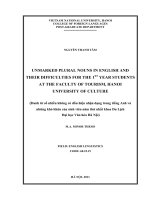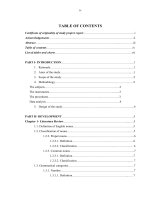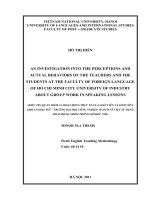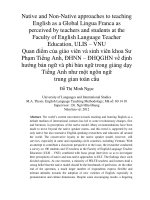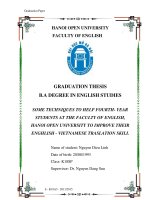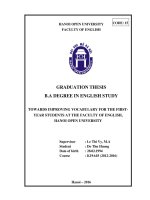Native and Non-Native approaches to teaching English as a Global Lingua Franca as perceived by teachers and students at the Faculty of English Language Teacher Education, ULIS – VNU
Bạn đang xem bản rút gọn của tài liệu. Xem và tải ngay bản đầy đủ của tài liệu tại đây (178.07 KB, 12 trang )
Native and Non-Native approaches to teaching
English as a Global Lingua Franca as
perceived by teachers and students at the
Faculty of English Language Teacher
Education, ULIS – VNU
Quan điểm của giáo viên và sinh viên khoa Sư
Phạm Tiếng Anh, ĐHNN – ĐHQGHN về định
hướng bản ngữ và phi bản ngữ trong giảng dạy
Tiếng Anh như một ngôn ngữ
trung gian toàn cầu
Đỗ Thị Minh Ngọc
University of Languages and International Studies
M.A. Thesis. English Language Teaching Methodology; Mã số: 60 14 10
Supervisor : Dr. Ngô Hữu Hòang
Năm bảo vệ: 2012
Abstract. The world‟s current movement towards teaching and learning English as a
default medium of international contacts has led to some revolutionary changes, first
and foremost, in perceptions of the native model. Many recommendations have been
made to move beyond the native speaker norms, and this trend is supported by not
only native but also nonnative English-speaking researchers and educators all around
the world. The conservative loyalty to the native speaker model, however, still
survives, especially in outer and expanding circle countries, including Vietnam. With
an attempt to contribute a classroom perspective to the issue, the researcher conducted
a survey on 100 students and 25 teachers at the Faculty of English Language Teacher
Education (ULIS – VNU) combined with focus group interviews so as to investigate
their perceptions of native and non-native approaches to ELT. The findings show such
divided opinions. At one extreme, a minority of FELTE teachers and learners hold a
strong belief that the native model should be the benchmark of perfection. At the other
end of the spectrum, a much larger number of respondents express flexible and
tolerant attitudes towards the adoption of new varieties of English, especially in
pronunciation and culture dimensions. Despite some encouraging results, a lingering
aspiration to the achievement of native-like competence can be sensed via the
students‟ majority preference of native English-speaking teachers and Vietnamese
teachers‟ self-doubt and feelings of inferiority. This study‟s results hopefully can
develop a glimpse of Vietnamese current language education so that some measured
pedagogical developments can be achieved.
Keywords. Phương pháp giảng dạy; Tiếng Anh; Bản ngữ
Content.
The paper is developed into three main parts:
PART I is Introduction. This part includes general details that serve as the
research background leading to the formation of research needs. The impetus for the
study and a brief review of some key studies in the field were discussed prior to the
introduction of research objectives, research questions, the scope and its significance.
PART II – Development is divided into three chapters.
Chapter 1 - Theoretical background is devoted to the clarification of
important theoretical issues. It is comprised of two sub-sections: (1) Key concepts in
ELF (providing the definition of some key terms in ELF) and (2) Native model versus
Non-native model (reviewing current research and controversies related to NESTs and
NNESTs, the native-speaker Model and non-native speaker Model)
Chapter 2 is Research Methodologies, which explains the context, the
selection of participants, the research approach as well as specific methods used in data
collection and data analysis.
Chapter 3 is Findings Analysis and Discussion. The findings from the
questionnaire and interview are presented, described and interpreted.
PART III is Conclusion and Recommendations. This part includes the
summary of key points developed throughout the paper, the pedagogical
recommendations, the explanation of study limitations, and finally some suggestions
for further studies to all of those who share the similar interest in the issue.
References.
In English
Adamson, B. (2004). China’s English. A history of English in Chinese education. Hong
Kong SAR, China: University of Hong Kong Press.
Aguilar, M. J. C. (2007). Dealing with Intercultural Communicative Competence in the
Foreign Language Classroom. In E. A. Soler & M. P. S. Jordà (Eds.), Intercultural
Language Use and Language Learning (pp. 59-78): Springer Netherlands.
Aliakbari, M. (2002). Linguistic Imperialism, linguistic democracy and English
language teaching. Retrieved on July 17
th
, 2012 from
www.stc.arts.chula.ac.th/ITUA/ /Linguistic%20Imperialism.pdf
Alptekin, C. (1993). Target-language culture in ELT materials. ELT Journal, 47/2, 136-
143.
Baker, W. (2009). The Cultures of English as a lingua franca. TESOL Quarterly 43/4,
567- 592.
Barratt, L. & E. Kontra (2000). Native English-speaking teachers in cultures other than
their own. TESOL Journal 9/3, 19-23.
Bieswanger, M. (2007). Language and Education. In Bieswanger (2008).
Bieswanger, M. (2008). Varieties of English in current English language teaching.
Stellenbosch in Linguistics 38, 27-47.
Bloomfield, L. (1933). Language. New York: Holt Rinehart Winston.
Bolton, K. (2003). Chinese Englishes. Cambridge: CUP.
Bolton, K. (2004). World Englishes. In A. Davies & C. Elder (Eds.), The handbook of
applied linguistics. Oxford: Blackwell.
Braine, G. (1999). Non-native educators in English Language Teaching. Mahwah, NJ:
Lawrence Erlbaum.
Braine, G. (2004). The non-native English-speaking professionals’ movement and its
research foundations. In Kamhi-Stein (Ed.), 9-24.
Brown, H. D. (1994). Teaching by Principle: An interactive approach to language
pedagogy. Englewood Cliffs, NJ: Prentice Hall Regents.
Brown, A., Deterding, D., and Ee Ling, L. (2000). The English language in Singapore.
Research on pronunciation. Singapore: Singapore Association for Applied
Linguistics.
Brumfit, C.J. (Ed.). (1982). English for International Communication. Oxford:
Pergamon.
Brutt-Griffler, J. (2002). World English. Clevedon: Multilingual Matters.
Burnes, A. (1999). Collaborative Action Research for English Teachers. Cambridge:
Cambridge University Press.
Butler, Y. (2007). Factors associated with the notion that native speakers are the ideal
language teachers: An examination of elementary school teachers in Japan. JALT
Journal 29(1)
Byram, M (1988). Cultural identities in multilingual classroom. In Cenoz, J. & F.
Genesee (Eds.), Beyond Bilingualism. Clevedon: Multiingual Matters, 96-116.
Canagarajah, A. S. (2006). Negotiating the local in English as a lingua franca. Annual
Review of Applied Linguistics 26, 1970218.
Canagarajah, A. S. (2005). Changing communicative needs, shifting pedagogical
priorities, revised assessment objectives. Paper presented at featured symposium
on The Assessment of World Englishes, 14
th
World Congress of Applied
Linguistics, Madison, WI.
Canagarajah, A. S. (2007). Lingua franca English, multiplingual communities, and
language acquisition. The Modern Language Journal, 91, 923-939.
Canagarajah, S., & Said, S. B. (2009). English language teaching in the outer and
expanding circles. In J. Maybin & J. Swann (Eds.), Routledge Companion to
English Language Studies (pp. 157-170). New York and Abingdon: Routledge.
Cheung, Y. L. (2002). The attitude of university students in Hong Kong towards native
and non-native teachers of English. Master‟s thesis, The Chinese University of
Hong Kong.
Cheung, Y. L., & Braine, G. (2007). The attitudes of university students towards non-
native speakers English teachers in Hong Kong. RELC Journal 38(3), 257-277.
Chomsky, N. (1965). Aspects of the Theory of Syntax. Cambridge, Mass.: MIT Press.
Cook, V. (1999). Going beyond the native speaker in language teaching. TESOL
Quarterly, 33, 185-209.
Cook, V. (2005). Basing teaching on the L2 user. In Llurda, E. (2005), Non-native
language teachers: Perception, challenges, and contribution to the profession.
New York: Springer.
Coppieters, R. (1987). Competence difference between native and near-native speakers.
Language 63, 544-573.
Cortazzi, M., & Jin, L. (1999). Cultural mirrors: Materials and methods in the EFL
classroom. In E. Hinkel (Ed.), Culture in second language teaching, 196-219.
Cambridge: CUP.
Coskun, A. (2010). Whose English should we teach: Reflections from Turkey. ESP
World, 1/27
Crystal, D. (1997). English as a global language. Cambridge: CUP.
Crystal, D. (2004). The language revolution. Cambridge: Polity.
Davies, A. (1991). The Native Speaker in Applied Linguistics. Edinburgh: Edinburgh
University Press.
Denzin, N. &Lincoln, Y. (2000). Handbook of Qualitative Research. London: Sage
Publication Inc.
Deterding, D., Brown, A., & Ee Ling, L. (2005). English in Singapore: Phonetic
research on a corpus. Singapore: McGraw Hil.
Dewey, M. (2007). English as a lingua franca and globalization: An interconnected
perspective. International Journal of Applied Linguistics, 17, 332-354.
Do, H. T. (2000). Foreign language education in Vietnam: The emergence of English
and its impact on higher education. In J. Shaw, D. Lubeska, & M. Noullet (Eds.),
Language and development: partnership and interaction: Proceedings of the
Fourth International Conference on Language and Development. Bangkok: Asian
Institute of Technology.
Edge, J. (1988). Natives, speakers, and models. JALT Journal, 9, 153-157.
Erling. E. (2005). The many names of English. English Today 81/21, 40-44.
Firth, A. (1996). The discursive accomplishment of normality. On „lingua franca‟
English and conversation analysis. Journal of Pragmatics 26, 237-259.
Firth, A. & Wagner, J. (1997). On discourse, communication, and (some) fundamental
concepts in SLA research. Modern Language Journal, 81, 285-300.
Fukumura, A. (1993). Qualifications of Language Teachers and English as an
International Language. TESL Reporter 26/1, 29-34.
Gnutzman, C. (2000). Lingua franca. In Byram, M. (Ed.). The Routledge Encyclopedia
of Language teaching and Learning. London: Routledge, 356-359.
Graddol, D. (1997). The future of English. London: British Council.
Graddol, D. (1999). The decline of the native speaker. AILA Review 13, 57-68.
Halliday, M. A. K., MacIntosh, A., & Strevens, P. (1964). The linguistic sciences and
language teaching. London: Longman.
Hinkel, E. (Ed.). (1999). Culture in second language teaching. Cambridge: CUP.
Ho, W. K., & Ward, C. (2000). Language in the global context. Singapore: SEAMEO
Regional Language Centre.
House, J. (1999). Misunderstanding in intercultural communication: Interactions in
English as a lingua franca and the myth of mutual intelligibility. In: Gnutzmann, C.
(Ed.) Teaching and Learning English as a Global Language. Tubingen:
Stauffenburg, 73-89.
Jenkins, J. (2000). The Phonology of English as an International Language. Oxford:
OUP
Jenkins, J. (2003). World Englishes: A resource book for students. London: Routledge.
Jenkins, L. (2006). Current perspectives on teaching World Englishes and Englishas a
lingua franca. TESOL Quarterly, 40/1, 157-181.
Johnson, K. & Johnson,H. (Eds.). (1998). Encyclopedia dictionary of applied linguistics.
Oxford: Blackwell.
Johnson, D. M. (1991). Approaches to Research in Second Language Learning. London:
Longman.
Kachru, B. B. (1982). The other tongue. English across cultures. Urbana: University of
Illinois Press.
Kachru, B. B. (1985). Standards, codification and sociolinguistic realism: The English
language in the outer circle. Cambridge: CUP.
Kachru, B. B. (1986). The Alchemy of English: The Spread, Functions and Models of
Non-native Englishes. Oxford: Pergamon Press
Kachru, B. B. (1989). Teaching World Englishes. Indian Journal of Applied Linguistics,
15/1, 85-95
Kachru, B. B. (2005). Asian Englishes: Beyond the canon. China: University of Hong
Kong Press.
Kamhi-Stein, L., Aagard, A., Ching, M-S, A. Paik & L. Sasser. (2004). Teaching in
kindergarten through grade 12 programs: Perceptions of native and nonnative
English-speaking practitioners. In Kamhi-Stein (ed.), Learning and teaching from
experience: Perspectives on nonnative English-speaking professionals. Ann Arbor,
MI: University of Michigan Press.
Kim, T. (2007). The interrelations among accentedness, comprehensibility,
intelligibility, and interpretability of nonnative English speaking teachers from the
perspectives of English as a Second Language students. Master‟s thesis, California
State University, Los Angeles.
Kirkpatrick, A. (2002). Englishes in Asia: Communication, identity, power and
education. Melbourne: Language Australia.
Kramsch, C. (1993). Context and Culture in Language Teaching. Oxford: OUP.
Kresovich, B. M. (1988). Error gravity: Perceptions of native-speaking and non-native
speaking faculty in EFL. (ERIC Document Reproduction Service No. 311 732).
Kubota, R. (2002). The impact of globalization on language teaching in Japan. In D.
Block & D. Cameron (Eds.), Globalization and language teaching. London:
Routledge.
Kuo, I-C. (2006). Addressing the issue of teaching English as a lingua franca. ELT
Journal, 60/3, 213-221.
Lee, I. (2000). Can a nonnative English speaker be a good English teacher? TESOL
Matters 10/1, 19.
Liang, K. (2002). English as a second language (ESL) students’ attitudes towards
nonnative English-speaking teachers’ accentedness. Master‟s thesis, California
State University, Los Angeles.
Liu, J. (1999). Non-native English speaking professionals in TESOL. TESOL Quarterly,
33/1, 85-102.
Lowenberg, P. (2002). Assessing English in proficiency in the expanding circle. World
Englishes, 21, 431-435.
Llurda, E. & A. Huguet. (2003). Seld-awareness in NNS EFL primary and secondary
school teachers. Language Awareness 13, 220-235.
Llurda, E. (2005). Non-native language teachers: Perceptions, challenge, and
contribution to the profession. New York: Springer.
Mahboob, A. (2003). Status of non-native English speaking teachers in the United
States. Bloomington: Indiana University.
Mahboob, A. (2004). Native or non-native: What do the students think? In L. D. Kamhi-
Stein (Ed.), Learning and Teaching from Experience: Perspectives on Non-native
English speaking professionals. Michigan: University of Michigan Press.
Matsuda, A. (2002). International understanding through teaching world Englishes.
World Englishes, 21/3, 436-440.
Mauranen, A. (2003). The corpus of English as Lingua Franca in Academic Settings.
TESOL Quarterly 37, 3, 513-527.
McArthur, A. (1987). The English language. English Today 11, 9-13.
McArthur, T. (1992). The Oxford Companion to the English Language. Oxford: OUP.
McArthur, A. (2001). World English and World Englishes: Trends, tension, varieties,
and standards. Language Teaching, 34, 1-20.
McAurthur, T. (2002). Oxford guide to world English. Oxford: OUP.
McKay, S. L. (2002). Teaching English as an International language: rethinking goals
and approaches. Oxford: OUP.
McKay, S. L. (2003). Teaching English as an International Language: the Chilean
context. ELT Journal, 57/2, 139-148.
McKay, S. L. (2003). Toward an appropriate EIL pedagogy: re-examining common ELT
assumptions. International Journal of Applied Linguistics, 13/1.
Melcher, G. & Shaw, P. (2003). World Englishes. London: Arnold.
Medgyes, P. (1992). Native and Non-native: who‟s worth more. ELT Journal, 46/4, 340-
349.
Medgyes, P. (1994). The non-native teacher. London: Macmillan.
Medgyes, P. (1999). Language training: A neglected area in teacher education. In
Braine (Ed.), 177-196.
Medyes, P. (2001). When the teacher is a non-native speaker. In M.Celce-Murcia (Ed.),
Teaching English as a second or foreign language. Boston: Heinle & Heinle.
Meierkord, C. (2002). ‘Language stripped bare’ or ‘linguistic masala’? Culture in
lingua franca communication. Frankfurt A.M.: Peter Lang.
Merino, I. G. (1997). Native English - Speaking Teachers versus Non-Native English-
Speaking Teachers. Revista Alicantina de Estudios Engleses 10, 69-79.
Modiano, M. (2001). Linguistic imperialism, cultural integrity, and EIL. ELT Journal
55/4, 339- 346.
Modiano, M (2005). Cultural studies, foreign language teaching and learning practices,
and the NNS practitioner. In Llurda (Ed.), 25-43.
Morita, N. (2004). Negotiating participation and identity in second language academic
communities. TESOL Quarterly, 38/4, 573-603.
Moussu, L. (2002). English as a second language students’ reactions to nonnative
English speaking teachers. In Moussu, L., & Llurda, E. (2008).
Moussu, L. (2006). Native and nonnative English-speaking English as a second
language teachers: Student attitudes, teacher self-perceptions, and intensive
English program administrator beliefs and practices. In Moussu, L., & Llurda, E.
(2008).
Moussu, L., & Llurda, E. (2008). Non-native English speaking English language
teachers: History and Research. Language Teaching, 41/3, 315-348.
Nayar, P. B. (1994). Whose English is it? TESL-EJ 1.1, F-1.
Nickel, G. (1985). How „native‟ can (or should) a non-native be? ITL Review of Applied
Linguistics 67/68, 141-160.
Norton, B. (1997). Language, identity, and the ownership of English. TESOL Quarterly,
31, 409-429.
Nunan, D. (2001). English as a global language. TESOL Quarterly, 35, 605-606.
Nunan, D. (2003). The impact of English as a global language on educational policies
and practices in the Asia-Pacific Region. TESOL Quarterly, 37/4, 589-613.
Paikeday, T. M. (1985). The Native Speaker is Dead! Toronto: Paikeday Publishing,
Inc.
Pakir, A. (1992). Words in a cultural context. Singapore: UniPress.
Pennington. M. C. (1998). Language in Hong Kong at century’s end. China: Hong Kong
University Press.
Pennycook, A. (1994). The Cultural Politics of English as an International Language.
London: Longman.
Pennycook, A. (1998). The cultural politics of English as an International language.
London: Longman
Pennycook, A. (2007). Global Englishes and Transcultural Flows. London, New York:
Routledge.
Penny Ur. (2009). English as a lingua franca and some implications for English
teachers. Retrieved July, 2012 from
www.tesol-france.org/Colloquium09/Ur_Plenary_ Handouts.pdf
Pham, H.H., (2001). A second look at the question of the ownership of English.
Teacher’s Edition, November 2011, 4-10.
Phan, T. T. H. (2009). Impacts of Vietnam‟s social context on learners‟ attitudes towards
foreign languages and English language learning: Implications for teaching and
learning. Asian EFL Journal, 11, 169-188.
Phillipson, R. (1992). ELT: The native speaker‟s burden? ELT Journal, 46, 12-18.
Phillipson, R. (1992). Linguistic Imperialism. Oxford: OUP.
Platt, J., Weber, H., & Ho, M. L. (1984). The new Englishes. London: Routledge &
Kegan Paul.
Pride, J. (1981). Native competence and the bilingual/ multilingual speaker. English
World Wide 2.2, 141-153.
Quirk, R. (1985). The English language in a global context. In R. Quirk & H. G.
Widdowson (Eds.), English in the world: Teaching and learning the language and
literatures, 1-6. Cambridge: CUP.
Rampton, M. B. H. (1990) . Displacing the „native speaker‟: Expertise, affiliation and
inheritance. ELT Journal, 44/2, 97-101.
Reves, T., & Medgyes, P. (1994). The non-native English speaking EFL/ESL teacher‟s
self-image: an international survey. System, 22/3, 353-367.
Risager, K. (2006). Languge and culture: Global flows and local complexity. Clevedon:
Multilingual Matters.
Samarin, W. (1987). Lingua franca. In U. Ammon, N. Dittmar, & K. Mattheier (Eds.),
Sociolinguistics: An international handbook of the science of language and society
(pp. 371-374). Berlin: Walter de Gruyter.
Schneider, E. W. (2011). English around the world. An introduction. Cambridge: CUP.
Seidlhofer, B. (1999). Double standards: teacher education in the expanding circle.
World Englishes 18/ 2, 233-245
Seidlhofer, B. (2001). Closing a conceptual gap: The case for a description of English as
a lingua franca. International Journal of Applied Linguistics, 11, 133-158
Seidlhofer, B. (2003). A concept of international English and related issues: from ‘real
English’ to ‘realistic English’. Strasbourg: Council of Europe.
Seidlhofer, B. (2004). Research perspectives on teaching English as a lingua franca.
Annual Review of Applied Linguistics 24, 209-239.
Seidlhofer, B. (2005). Standard future or half-baked quackery? In C. Gnutzmann & F.
Intermann (Eds.), The globalization of English and the English language
classroom, 159-173. Germany: Narr.
Selinker, L. (1972). Interlanguage. International Review of Applied Linguistics, 10, 209-
231.
Shank, G. (2002). Qualitative research: A personal skill approach. New Jersey: Merril
Prentice Hall.
Shaw, D. (1981). Asian students attitudes towards English. In L. Smith (Ed.) (1983),
Readings in English as an international language. Oxford: Pergamon Press.
Smith, L. (1976). English as an International auxiliary language. RELC Journal 7/2, 38-
43.
Sowden, C. (2011). ELF on a mushroom: the overnight growth in English as a lingua
franca. English Language Teaching Journal 66(1), 89-96.
Stanlaw, J. (2004). Japanese English: Language and culture contact. Hong Kong SAR,
China: Hong Kong University Press.
Stern, H. H. (1983). Fundamental concepts of language teaching. Oxford: OUP.
Tajino, A. & Tajino, K. (2000). Native and Non-native: What can they offer? ELT
Journal 54/1, 3-11
Takeshita, Y. (2001). Ten linguistic issues in Japan: The impact of globalization. In
Kachru, Y. (Eds.), World Englishes and Language Education. Urbana: University
of Illinois
Tarone, E. (2005). Schools of Fish: English for Access to International Academic and
Professional Communities. The Journal of Asia TEFL 2/1, 1-20
Timis, I. (2002). Native-speaker norms and International English: A classroom review.
ELT Journal 56, 240-249.
Ton, N.N.H & Pham, H.H., (2010). Vietnamese teacher‟s and students‟ perceptions of
global English. Language Education in Asia, 1/1, 46-81.
Tran, L. (2002). A Vietnamese perspective on World Englishes. Teacher’s Edition 4,
26-32.
Ulate, N.V. (2011). Insights towards Native and Non-Native ELT Educators. Bellaterra
Journal of Teaching and Learning and Literature, 4/1, 56-79.
Vlades, J. M. (1986). Culture bound: Bridging the cultural gap in language teaching.
Cambridge: CUP.
Widdowson, H. C. (1994). The ownership of English. TESOL Quarterly 28, 377-388.
Whorf, B. L. (1939). The relation of habitual thought and behavior to language. In W.
Baker (2009), The Cultures of English as a lingua franca. TESOL Quarterly 43/4.
Wright, S. (2002). Language education and foreign relations in Vietnam. In J. W.
Tollefson (Ed.), Language policies in education: Critical issues, 225-244. London:
Lawrence Erlbaum.
In Vietnamese
Hoang, Van Van (2010). Dạy Tiếng Anh không chuyên ở các trường đại học Việt
Nam: Những vấn đề lí luận và thực tiễn. Hà Nội: Nhà xuất bản Đại học Quốc gia
Hà Nội.
Hoàng, Văn Vân (2011). Vị thế của tiếng Anh trên thế giới và ở Việt Nam. T/c Ngôn
ngữ số 1, 11-18.
Ngô, Hữu Hoàng (2012). Tiếng Anh toàn cầu và giao tiếp liên văn hóa. Báo cáo hội
thảo khoa học-Đại Học Ngoại ngữ-Đại Học Quốc Gia Hà Nội, 2012
Ngô, Hữu Hoàng (2012). Toàn cầu hóa và ngôn ngữ toàn cầu: Một nghiên cứu quốc tế
học về tiếng Anh- Công trình nghiên cứu khoa học cấp cơ sở - Đại Học Ngoại
Ngữ-Đại Học Quốc Gia Hà Nội, 2012
Võ, Thị Thao Ly (2009). Tiếng Anh “chuẩn” của người bản ngữ hay Tiếng Anh như
ngôn ngữ quốc tế? Tạp chí khoa học, 3, 5-11. Đại học Đà Nẵng.
